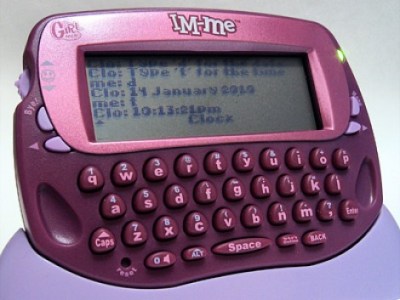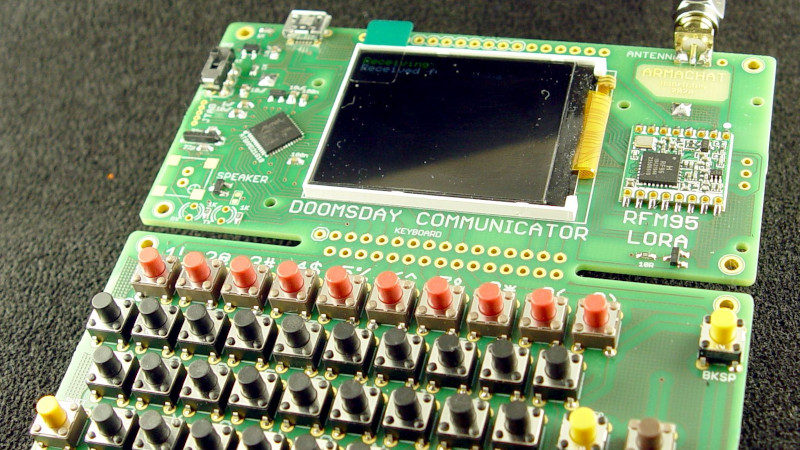Enshrined in the hacker hall of fame, the IM-Me was an instant messaging toy that turned out to be extremely hackable. You could easily ditch its instant messaging platform to turn it into a little spectrum analyser. Of course what’s old is new again, and in this age where we no longer have the Nokia 3110, the Sidekick, or even Blackberries, how shall we get our fix of those wireless gadgets with physical keyboards?
What would happen if a hacker had a go at creating one of those? [Bobricius]’ Armachat is an instant messaging platform that uses LoRa as its over-the-air protocol, and is powered by a Microchip ATSAMD21x18 ARM Cortex M0 microcontroller alongside an RFM95 LoRa module.

There are two versions of the device for hand and pocket, both of which come with QWERTY keyboards made with momentary-action switches, 18650 cell power, and LCD screens. The idea is that it could form a robust communication system when many others have failed.
As it stands they have a simple text messaging app in the firmware, but there are other features yet to come. Perhaps the most interesting is a possible store-and-forward meshing system in the future, which would make this a powerful comms tool in so many circumstances. Both of [Bobricius’] devices can be seen in the video below the break — no word from him on the possibility of a pink case option. Meanwhile [Bobricius] has appeared on these pages many times before. With so many to choose from it’s hard to pick one, but his Nixie-like LED display is quite memorable.
















Operation preview video https://youtu.be/j9qWJNcTHWI
What about the Cybiko? https://en.wikipedia.org/wiki/Cybiko
Came here to say this, lots of downloadable resources here:
download.cybiko.net
A modern version of this would be fantastic
Oh that’s a wonderful blast from the past! I loved my Cybiko with its weird early 2000s-style translucent neon-colored plastic case. Really wish that community took off more than it ever did.
I still have a couple of these in my project box. I pull them out every once in a while, wondering what I could do with them now.
Think for a doomsday communicator being low power would be an absolute must. Would like to see an ultra low power e-ink based version with a super wide input charging port (so you can charge it off car batteries you find about and other similar power sources.
Or just a little solar panel like an old calculator. Hell, that would probably power everything just fine until it needs to TX, and maybe a method could be designed so that a battery only gets involved when the radio is broadcasting, then gradually recharges otherwise. Maybe a hand crank like one of those old emergency flashlights.
It’s not so much about power. If power is available, it’s probably because someone has a generator, or can build a basic battery out of old soda cans or something.
The main issue is the 18650 lithium cell, which won’t have a good shelf life. 8-9 years tops, then it’s dead, and if it’s really supposed to be a “doomsday” communicator then you’ll have no replacements because everyone’s got the same problem. It’s the bane of the cordless power tool or the emergency flashlight: it sits on the shelf for years and then when you finally need it, the battery has died. Even non-rechargeable batteries have a maximum shelf-life of about 10 years.
The best emergency battery would be a lead-acid cell that is first charged and then dried out completely and hermetically sealed, so you add some distilled water when you want to use it. It keeps forever, powers up instantly, and once it’s used up it can be refurbished using very primitive technology and chemistry. Sulfuric acid distilled from old car batteries, lead from old car batteries, water, bits of wire and a box. That’s it. 18th century stuff.
Why not Nickel-Iron?
Wind up is the way to go. In the doomsday scenario, solar might not work…
Put an ultracap on it and call it a day….. Or even a bunch of ceramic caps.
The software for store and forward systems / protocols already exists, they are called smtp and nntp and where developed and used back in the days when 19200 baud modems where priced same as a good used car.
i also recommend a case study of the ham radio aprs digipieater implementation. there’s also some… not so good stuff.
Is it optimized to broadcast through a large, interconnected dynamic mesh network where nodes may move or go offline often? Like sending redundant copies through multiple routes to keep the mesh robust and help transmissions reach their destination as fast as possible? Or is it designed more for a network of fewer, mostly static nodes arranged in more or less a straight line?
SMTP and NNTP are indeed designed for dynamically changing network connections.
They replaced UUCP as the primary method of inter-network transfer of data, one of those main reasons being UUCP required the user to provide the route to take, assuming a small number of static nodes in a fixed topology that humans knew in advance.
NNTP is designed for usenet servers. It’s more of a distributed bulletin board system type of a thing than distributed instant messaging protocol. Same thing with SMTP.
It’s a rather heavy protocol for having a simple mesh network with packet forwarding having a short time to live, and not necessarily any acknowledgements sent back to source, and not much local storage to replicate the contents of the entire network.
Will have to look into what fidonet used as that was more optimised for lower spec home computers and low bandwidth links.
Fidonet didn’t have so much a protocol than a mob of administrators who were responsible for keeping things together and organizing/scripting the modem calls. Literally – they modeled it after the mafia.
The addressing system was based on geographical location, like telephone numbers before cellphones – because it was operating over POTS and you had to know who you could call on local rates.That also meant that you couldn’t “roam” as such – if you went to a different place, people had to know where you are to send you mail. For visiting another site, you effectively became a new user in each. For that reason, echomail was built to scour local systems for messages, zip it up, and then circulate the copy to everyone.
“sweat heart”? gross
so sweaty. ;)
* sweet heert
No pink case?
Sorry, that’s a deal breaker.
“Move on, nothing to see here!”
A friend just gave me a Cidco MailStation. It’s a nicely built gadget- sold for $99. It was a POTS dialup email terminal with a mono LCD screen. Must be good for something.
Well, I can use the wallwart.
something https://jcs.org/2019/05/03/mailstation
Huh. Bridgefy minus the cell phone, 2g,3g,LTE and 5g. Not bad not bad at all.
Og btw Bridefy is for “offline” phones and DOES use mesh networking protocols.